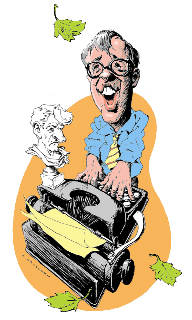Anytime you get the premonition that civilization might be doomed, you need no
firmer assurance of survival that the Saturday night series of concerts at the
J. Paul Getty Museum. You can’t get in, of course; the series is always sold
out. But it helps just to know it’s there: civilized, highly imaginative
programs presented in the most civilized setting.
Saturday’s program was the collaboration of two of UCLA’s blithe spirits, the
musical scholar Robert Winter and the theatrical director John Hall, who
between them concocted a replica of an 18th-century London musical and
dramatic entertainment. The framework, as conceived by Hall, consisted of a
confrontation between a troupe of hoity-toity Italian opera singers and some
English comedians. They squabble as to whose is the higher art and then, in
the manner of Richard Strauss’s “Ariadne auf Naxos,” they reconcile their
difference and put on their combined show.
The idea was genial, but what made it work was the high quality of the music
— a pastiche of songs and arias by popular composers of the time, including
Thomas Arne, George Friedrich Handel and Stephen Storace — and the level of
performance. All six singers — sopranos Laura Freeze, Frances Young and Shawn
Daywalt; countertenor Brian Asawa, tenor Dale Trecy and baritone Jeff Calof —
are active in opera workshops in and around Los Angeles — and all were first
rate. Young Asawa, 23 and still finishing his studies at U.S.C., sang his
stratospheric roulades with a marvelous ease and purity of style; he is
someone to watch.
The music was mostly unfamiliar and included some delightful rareties: songs
and ensembles from a 1794 opera by Stephen Storace called “The Cherokee,”
whetting the appetite for a complete performance; a ravishing trio from
Handel’s “Imeneo” and, as an encore, Thomas Arne’s original operatic setting
of “Rule, Britannia.”
It was, then, a captivating idea for a concert, and brilliantly brought off,
with surprise and delight around every turn. Robert Winter officiated at the
harpsichord. The evening’s damp air did raise some havoc with the fragile old-
style instruments of Greg Maldonado’s Los Angeles Baroque Orchestra; the group
has sounded better-tuned on other occasions. Oh well, a small price to pay for
an evening of treasures beyond price.
There’s one concert left in this summer’s series, on August 25, sold-out as
usual. Maybe if you sneaked in a couple of days before, and hid behind the Van
Gogh…
-

-
Categories
-
-
Archives
- April 2010
- February 2010
- December 2009
- November 2009
- October 2009
- September 2009
- June 2009
- May 2009
- April 2009
- March 2009
- February 2009
- January 2009
- December 2008
- November 2008
- October 2008
- September 2008
- August 2008
- July 2008
- June 2008
- May 2008
- April 2008
- March 2008
- February 2008
- January 2008
- December 2007
- November 2007
- October 2007
- September 2007
- August 2007
- July 2007
- June 2007
- May 2007
- April 2007
- March 2007
- February 2007
- January 2007
- December 2006
- November 2006
- October 2006
- September 2006
- August 2006
- July 2006
- June 2006
- May 2006
- April 2006
- March 2006
- February 2006
- January 2006
- December 2005
- November 2005
- October 2005
- September 2005
- August 2005
- July 2005
- June 2005
- May 2005
- April 2005
- March 2005
- February 2005
- January 2005
- November 2004
- October 2004
- September 2004
- August 2004
- July 2004
- June 2004
- May 2004
- April 2004
- March 2004
- February 2004
- January 2004
- December 2003
- November 2003
- October 2003
- September 2003
- August 2003
- July 2003
- June 2003
- May 2003
- April 2003
- March 2003
- February 2003
- January 2003
- December 2002
- November 2002
- October 2002
- September 2002
- August 2002
- July 2002
- June 2002
- May 2002
- April 2002
- March 2002
- February 2002
- January 2002
- December 2001
- November 2001
- October 2001
- September 2001
- August 2001
- July 2001
- June 2001
- May 2001
- April 2001
- March 2001
- February 2001
- January 2001
- December 2000
- November 2000
- October 2000
- September 2000
- August 2000
- July 2000
- June 2000
- May 2000
- April 2000
- March 2000
- February 2000
- January 2000
- December 1999
- November 1999
- October 1999
- September 1999
- August 1999
- July 1999
- June 1999
- May 1999
- April 1999
- March 1999
- February 1999
- January 1999
- December 1998
- November 1998
- October 1998
- September 1998
- August 1998
- July 1998
- June 1998
- May 1998
- April 1998
- March 1998
- February 1998
- January 1998
- March 1992
- February 1992
- January 1992
- December 1991
- November 1991
- October 1991
- September 1991
- August 1991
- July 1991
- June 1991
- May 1991
- April 1991
- March 1991
- February 1991
- January 1991
- December 1990
- November 1990
- October 1990
- September 1990
- August 1990
- July 1990
- June 1990
- April 1990
- January 1990
- July 1989
- June 1989
- May 1989
- April 1989
- March 1989
- February 1989
- January 1989
- January 1983
-

Alan's Poppies and Sage, photographed by Paul Cabanis, Spring 2010.


